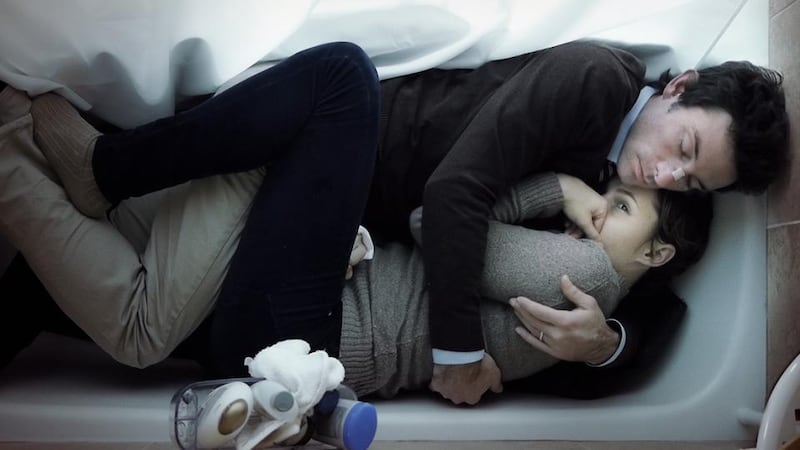After several years of biblical torrents, the weather decided to put on a decent show for the 25th edition of the Galway Film Fleadh. Mind you, was this what the organisers really wanted? The subtropical fug may have lured auslanders to the silver jubilee. But would they enter the cinema when they got there?
So it seemed. The traditional buzz seemed no less noisy than in previous years. And Gar O'Brien, the energetic young programmer, drummed up several impressive coups to celebrate the bash's anniversary. For the first time, the fleadh offered punters a surprise film. Zachary Quinto, Mr Spock in the current Star Trek series, was on hand to dramatically unveil the second ever festival screening of JC Chandor's All Is Lost. Quinto co-produced the drama, which stars Robert Redford as a lone sailor lost at sea.
Two of the year's best American pictures also screened as part of the international selection. Noah Baumbach's Frances Ha features the perennially off-beam Greta Gerwig as a very mildly gifted dancer sent into a tailspin when her flatmate leaves their New York apartment. The picture offers Baumbach's best blend of satire and indulgence since The Squid and the Whale.


If impenetrability is your thing then look no further than Shane Carruth's much anticipated follow-up to his extraordinary 2004 time-travel adventure Primer. Upstream Color, which begins with a woman being drugged by a mysterious conman, is a wilfully baffling, limpidly attractive film that swims in the same waters as Philip K Dick's fictions, but rapidly leaves the world of science fiction to access a kind of designer Dadaism. Nothing like it has been seen before.
New Irish features
The fleadh remains, however, most famous for its dedication to new Irish features. Not everything was magnificent (stuck for space, we will leave the wounded combatants unmolested by the side of the road) but the best films demonstrated the continuing variety and invention of domestic cinema.
John Murray and Emer Reynolds's Here Was Cuba was billed as the first major documentary on the Cuban missile crisis. This fine film, made in co-operation with US broadcaster PBS, drags together an exemplary series of witnesses – Sergei Khrushchev, son of Nikita, is particularly enlightening – to flesh out corners of the story rarely touched on before.
Also in the documentary strand, Gerry Gregg's gripping Close to Evil follows Tomi Reichental, a Holocaust survivor resident in Ireland, as he sets out to meet a nonagenarian woman who worked as a guard in Bergen-Belsen. Close to Evil offers sobering truths about the level of denial that still hangs around the Nazi genocide.
Two similarly titled films catered to horror enthusiasts. Colin Downey's The Shadows adapted a George MacDonald fairy story about parallel universes with intermittent success. The mythological imagery is soaked in gothic menace but the insistent voice-over is ultimately a little hard to bear.
Rossella De Venuto's House of Shadows – one of many international co-productions in the new Irish category – slotted into the genre known (to me anyway) as travelogue horror. The always-excellent Fiona Glascott plays an Irish woman holidaying in a spooky Italian villa with a history of ecclesiastic malignity. The picture, featuring an excellent crab infestation, proudly meets the criterion of superior hokum.
The closing film, Stephen Brown's The Sea, set itself the unenviable task of turning John Banville's novel of the same name – a Booker-winning tussle with memory and regret – into a manageable motion picture. The result, from a script by the novelist, is a very nicely crafted piece of "quality cinema" that never entirely escapes its literary origins.
Ciarán Hinds is reliably nuanced as a writer returning to the scene of a formative childhood experience. The contrast of smoky shades (for the present) and Kodacolor fuzz (for the past) is boldly effective. Stressing the mystery elements more heavily than did the book, Brown's film ends up playing like a particularly murky Ruth Rendell adaption. This is not meant as criticism.
The Irish film most likely to attract large mainstream audiences is surely Lance Daly's Life's a Breeze. After drawing critical kudos for Kisses – and receiving little attention for his US debut The Good Doctor – Daly has consciously attempted to serve up a comedy for the recession years.
The picture revels in a premise that could easily have driven an Ealing comedy. Fionnula Flanagan plays a slightly befuddled grand dame – materfamilias to users and grabbers – who falls into a resigned fury when a mattress stuffed with money gets left out for the binmen.
The picture cracks along at a great pace. It makes its social points forcefully without hectoring the viewer. And it knows just what to do with its fine cast. Pat Shortt is funny and touching as a lovable fool. Flanagan owns the art of the indomitable. Young Kelly Thornton's performance again confirms that Daly is a genius at casting and directing children.
For all its popular appeal, Life's a Breeze was, however, beaten to the fleadh's prize for best Irish feature by Steph Green's touching Run & Jump. Green, director of the Oscar-nominated short New Boy, has taken a tricky, knotty script by Ailbhe Keogan and delivered a drama that, in its skilled juggling of raw emotion, recalls the work of Danish director Susanne Bier.
Versatile English actor Maxine Peake plays a woman coping admirably – if erratically – with a husband slowly recovering from a serious stroke. American star Will Forte is contained as the neuroscientist making a study of the patient. Edward MacLiam works hard at his brain-damaged, constantly frustrated subject. At times the story is a tad too busy, but this immaculately acted picture positively throbs with humanity and compassion.
Best of the Irish
This writer's favourite among the Irish pictures viewed was, however, something a bit more peculiar, a bit more low-key and even harder to categorise.
You could, if you were desperate, pigeonhole Donal Foreman's Out of Here as Celtic mumblecore. Then again, there's something positively Asian about its refusal to deal in grand gestures. The picture follows a young college dropout as he returns to Dublin after a year's travelling. Nothing much happens. The protagonist – played with a somnambulist's gait by Fionn Walton – wanders into a pub, goes for a cycle, chats to green activists and has a poker game with his friends. There is a faint undercurrent of menace to the deadened interactions. But, for the most part, Out of Here deals in off-centre humour.
The script obliquely references Richard Linklater's Before Sunrise and, like that picture (and like Frances Ha, for that matter), Foreman's piece is half-amused and half-frustrated by its often-precious characters. The film is also rather beautiful. Piers McGrail's camera locates huge fish just beneath the surface of Dublin Bay, makes something of two escalators powering in complementary competition, and helps compose a final shot that is brilliant in its uncomplicated invention.
Foreman's film came second to Run & Jump in the race for first Irish feature. Somehow or other, despite being included in the new Irish cinema section, George Kane's Discoverdale escaped the domestic lane to win best international feature. Fair enough. The mock rock documentary – though deeply in hock to This is Spinal Tap – is an absolute hoot that deserves its imminent cult status.
The comedy rock troupe Dead Cat Bounce travel the world when their lead singer discovers (get it?) that he may be the son of rock deity David Coverdale. But will the Whitesnake bellower appear?
"In Jaws the shark didn't appear until half way through," James Walmsley rationalises. "And in The Blair Witch Project the shark didn't appear at all."
Wise words.
See the full list of prizewinners at Donald Clarke’s Screenwriter blog, irishtimes. com/blogs/screenwriter
















